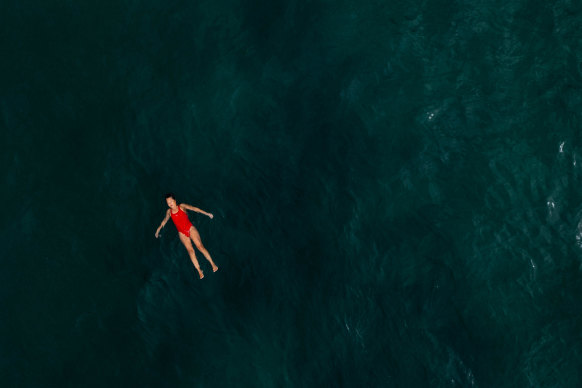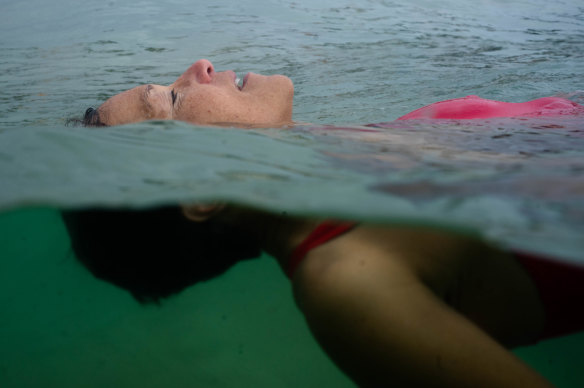- Exclusive
- National
- Water safety
This was published 3 years ago
‘Float to survive’ the message for swimmers this summer
By Julie Power
A pilot water safety program in Sydney’s eastern suburbs will attempt to avoid a repeat of last year’s record rate of drownings by urging the public to “float to survive” if they get into trouble in the water.
It’s a message Bondi resident Susan Woodland put into practice last year to save her life.

“The surf doubled in size”: Susan Woodland used her floating skills to survive while swimming at Bondi last year.Credit: Janie Barrett
On her birthday in November, she was swimming across Bondi when the swell changed.
“The surf doubled in size on the way back,” she said. “I got frightened. So, I waited out the back, floating for 15 minutes, until the rubber ducky came.”
Woodland knew people on the deck of the Icebergs Pool had seen her, so she tread water and floated, saving her energy until volunteer surf lifesavers rescued her.
To mark the beginning of summer, declared national water safety day by the federal government, Randwick City and Waverley councils will launch a new pilot water safety campaign urging the public to float to survive.
It is also the first day of the annual summer drowning toll that last year rose 30 per cent to 112 deaths on beaches, rivers, pools and other waterways.
The summer spike contributed to a 10-year high of 339 people who fatally drowned in rivers, dams, pools, rock fishing, in floodwaters and on beaches.
The rise was partly attributed to people seeking out new – and often unfamiliar and unpatrolled – beaches and waterways during the pandemic because they were close to home or less crowded.

Susan Woodland swims across the bay at Bondi frequently, but last year she was frightened in big surf and floated for 15 minutes. Credit: Janie Barrett
Throughout the summer, the councils will use text messages, and advertisements on bus shelters and in local cinemas, to target visitors at some of Sydney’s busiest beaches including Bondi, Coogee and Maroubra.
Randwick Mayor Dylan Parker said if you can master the skill of floating, even if you are not a good swimmer, you are more likely to survive and be rescued.
Bruce Hopkins, Waverley Council Lifeguard Service coordinator, said learning how to float “could be the difference between life and death”.
The program will be evaluated by Professor Rob Brander (aka ‘Dr Rip’), from UNSW’s Beach Safety Research Group to see if the public recalled the message.
Brander said swimmers would always get in trouble: “Floating gives you time, it allows you to look around and signal for help.”
The campaign also urges the public to swim between the flags, and on patrolled beaches and waterways.
In Thailand, children are taught to float, some for up to four hours, as part of swimming lessons. In the United Kingdom, the Royal National Lifeboat Institute is campaigning on the same theme.
Royal Life Saving Australia chief executive Justin Scarr said the message about floating applied to all waterways, and not just beaches.
“Swimmers in trouble should float, but the most important thing is to learn to swim. Too many people can’t swim these days, and floating is an integral part of swimming.”
Woodland, the sister-in-law of this reporter, learned to float horizontally and vertically when she earned Royal Life Saving awards.
This reporter has been called a “mighty fine floater, too”.
Five steps to float to survive
1. Keep calm and control your breathing
2. Lean back
3. Extend your arms and legs
4. Gently rotate your arms and legs in a circular motion
5. Signal for help with your hand if you can
The Morning Edition newsletter is our guide to the day’s most important and interesting stories, analysis and insights. Sign up here.